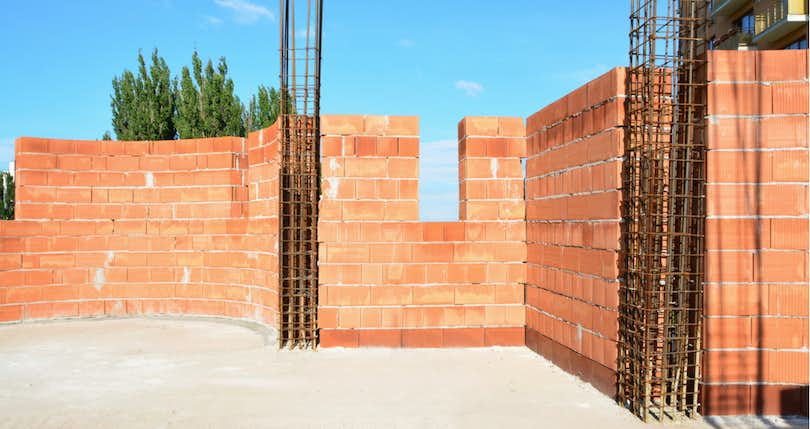Load-bearing walls transfer the weight of a house right down to the foundation. Read on to find out how to identify a load-bearing wall and what you need to know if you decide to remove one.

Many buyers choose to renovate a home soon after they’ve purchased it. It’s natural to want to give the space a personal touch when you move in.
If you carry out a major renovation, you may have to deal with removing a load-bearing wall. This can be a big decision to make since load-bearing walls are a key structural component of any house.
What is a load-bearing wall?
If you look around your house, you will notice that there are two different kinds of walls. The first kind supports the structure above it, whether that’s a roof or another floor. The second kind of walls are just partitions, which is what separates one room from the other.
The first kind of wall, which carries the weight of the structure and supports the roof, is known as a load-bearing wall. These walls transfer the vertical load of the house straight to the foundation or some other element that undergirds it. This makes load-bearing walls a key structural element of any building.
Ways to Identify a Load-Bearing Wall
There are a few different ways to identify which the load-bearing walls in your house are. It’s imperative you get this right if you’re doing any kind of renovations or repairs that affect the structure of your house.
As said earlier, load-bearing walls transfer the weight of the structure down to the foundation. So an easy way to identify them is by looking at which walls are built over one another from floor to floor. But since we’re talking about a single story house, it can be a little harder to find out which the load-bearing walls are.
Things can get a little easier if you have a basement where the walls are exposed. This lets you see how the beams of the house are arranged. A wall that is built on top of the beam is usually a load-bearing wall.
The other structural element that you need to know about is the joist. These are parallel lengths of wood laid out horizontally to support the structure of a house. One way to tell if a wall is load bearing is if it is perpendicular to the joists. Again, you can go to an unfinished basement or attic to see how the walls have been constructed relative to the joists.
The important thing to remember while trying to identify load-bearing walls is that they support the structure of a house. Any wall that doesn’t seem to be holding up another wall or post is probably not a load-bearing wall.
Want to buy a house and rennovate it?
A Clever Partner Agent can help you stay on budget.
Why Identifying Load-Bearing Walls is Important
The main reason that homeowners look to tell if a load-bearing wall is if they’re carrying out some kind of renovation that requires the wall to be removed. This is usually done because they want to change the floor plan or create a larger space in some part of the house. It is possible to remove a load-bearing wall as long as it is replaced with a supporting structure like a beam or girder.
The first question you need to ask yourself if you’re renovating your house is if you absolutely need to remove the load-bearing wall. Given what an important structural element it is, taking out a load-bearing wall is not a simple process. You have to be sure about what you’re doing before approving the removal.
In most parts of the country, you will need a permit to remove a load-bearing wall. Local housing departments need to know if the changes being made can compromise the structure of a house. You may need to provide a plan drawn up by an engineer to show that you’re replacing the wall with the right support structures so that the structural integrity of the house is preserved. So make sure to check with the local permitting authority before doing any work on a load-bearing wall in your house.
Cost to Remove a Load-Bearing Wall
Since load-bearing walls are a key structural component, it can be costly to remove them.
It can cost anywhere between $1,200 and $3,000 to remove a load-bearing wall in your house. But you can’t stop there; you need to substitute the load-bearing wall with a different supporting structure. Installing a beam in place of a load-bearing wall can cost you a further $1,150 to $4,600.
These costs can seem significant, especially if you’re doing these renovations immediately after buying a new house. There are various hidden costs that come with buying a house and having to do major renovations right away may pose a financial challenge.
Hiring a Clever Partner Agent when buying a house can help you make up for these costs with our Clever Cash Back program. Buyers who work with a Partner Agent may be eligible to receive money back after the sale is final, depending on the state you're in. This money can be used to offset a part of the costs involved in removing a wall or other renovations.
We source Partner Agents from the best brokerages in the country. Every Clever Partner Agent has extensive local knowledge so they can provide home buyers with not just home buying assistance, but also information about the local market and service providers.
Contact Clever to connect with a Partner Agent who can help you buy your new house at a great price and offset renovation costs in the process.




